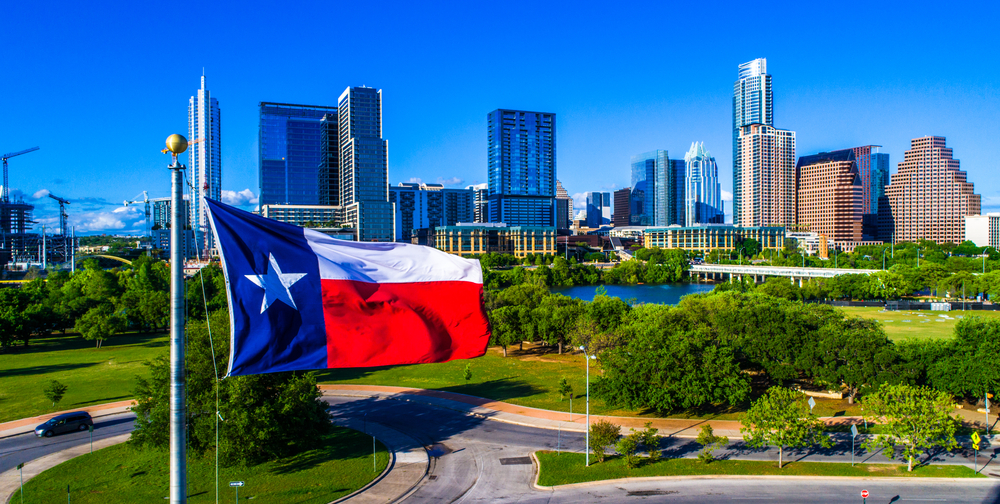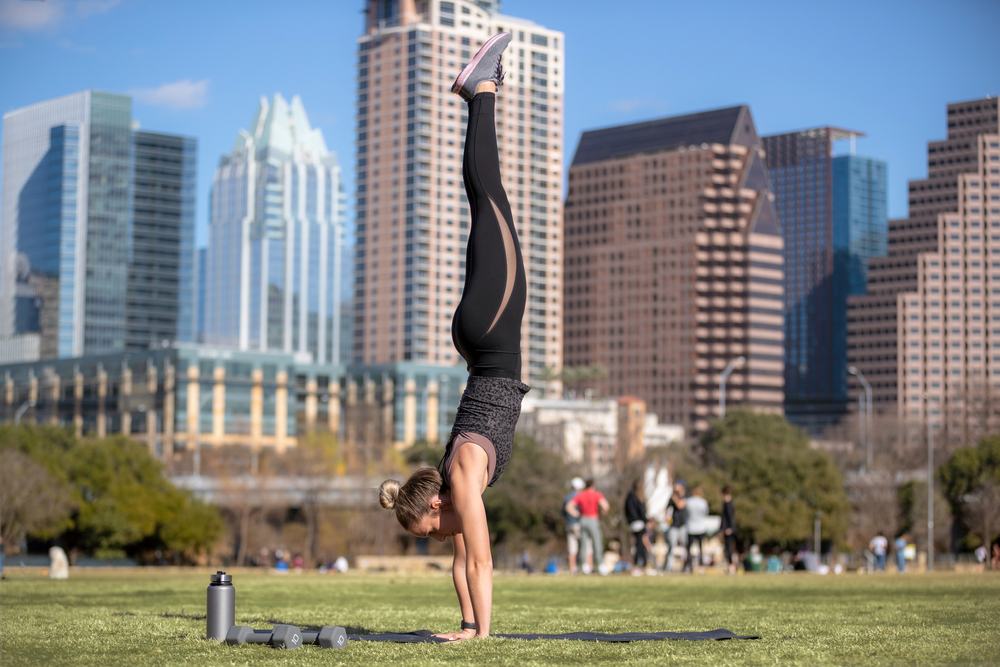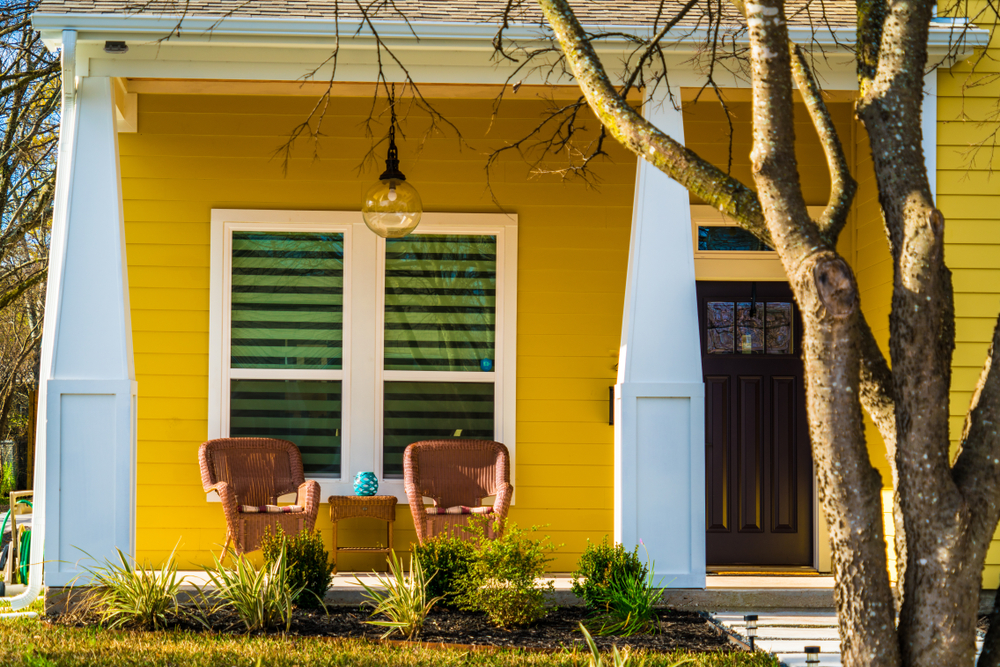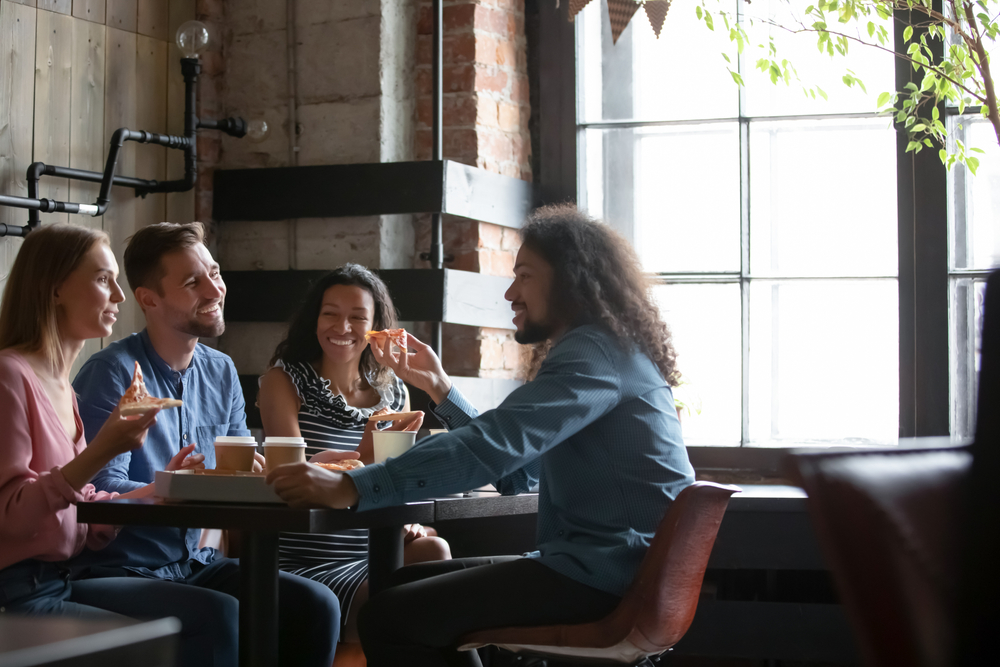Moving to Austin has been a hot topic over the last few years.
Maybe it’s the fact that the city had three first-place finishes in a row in U.S. News & World Report’s ‘Best Places to Live’ rankings. (It’s currently sitting at number 3 in the same poll, presumably because people were tired of voting for it.)
But it also might be the city’s advantages in the modern, connected world. Surprising as it may seem to those who knew the city before its growth spurt, Austin now ranks as the 11th-largest city in the country. With this rapid population growth — the city more than doubled in size in the past 30 years — has come a related growth in opportunity.
The millennial generation seems particularly compelled to move for opportunities. When those opportunities come with a side of world-famous nightlife, so much the better.
Why Move to Austin, Texas?

Photo: Roschetzky Photography/Shutterstock.com
Why are people moving to Austin? Maybe for the same reasons that you’re thinking.
And if you have been thinking about moving to Austin or somewhere nearby in Texas, we bet that you’ve thought about at least a few of these highlights.
Austin has much more to offer than its commitment to weirdness and its reputation as ‘The Live Music Capitol of the World.’
It has excellent schools and access to nature woven into every neighborhood. It has a humid subtropical climate, which some people like — or at any rate prefer to the colder parts of the country. There’s a reason that there’s been an exodus of people moving from NYC to Austin, TX.
And it’s also one of the reasons that U.S. News rated Austin the 29th-best place to retire in the country.
Oh, and did we mention the lack of state income tax?
If any of these sound like your style, our ‘Moving to Austin, Texas’ guide should give you a fuller picture. Read on for the pros (and a few cons) of moving to Austin, Texas.
Getting to Know the Austin Neighborhoods

Photo: El Nariz/Shutterstock.com
There’s an old Austin joke that goes like this: ‘How many Austinites does it take to change a lightbulb? Three. One to change the bulb and two to talk about how great the old bulb used to be.’
Nowhere is this dynamic more present than in the discussion of Austin’s growth.
For the lightbulb commentators, this growth has changed the Austin experience. It’s certainly led to more congestion, and greater difficulty moving across the city.
But as the city has gotten denser and more populous, formerly quiet neighborhoods have cultivated their own scenes.
Old timers talk about how the magic of Austin used to be in catching a show in south Austin then heading downtown for another. They miss the days when Austin was a big little city, with culture that far outstripped its size.
But places don’t stay undiscovered forever. If you’re moving to Austin or central Texas and looking for something particular, here’s the best current advice on where to find it.
Downtown
Downtown Austin is the home of the state capitol, as well as live music hub Sixth Street. It’s also close to the waterfront, with its many hiking and biking trails. There’s a reason that many who are moving to Austin rate this neighborhood near the top when they are deciding where to live.
Some of the city’s best restaurants and most venerated establishments are in downtown. Its safety and proximity to all of the best that the city has to offer has put it first on the map for many who are moving to Austin.
The Texas State Capitol Building is more than just a job engine for the city. Its grand architecture dates back more than a century, and is surrounded by walkable landscaping dotted with historical monuments. Altogether, this makes for the largest square footage of any state capitol building in the country.
Downtown’s cultural attractions don’t end on Sixth Street either. Rainey Street’s F&B scene is distinguished by its renovated bungalow bars. The Red River Cultural District is the place to find nightclubs. And the Warehouse District has taken neighborhood warehouses and renovated them into a hip hub for the LGBT scene.
North Austin
When it was rumored that the Obamas were moving to Austin in 2016, they were said to be considering north Austin. This makes sense when you consider the area’s proximity to both downtown and the emerging tech hub of ‘Silicon Hills.’
The high-density office, retail, and residential center The Domain is home to many of these tech companies moving to Austin.
Tesla is actually moving to north Austin. This follows Amazon’s move to north Austin — with 15 new buildings opening in the region. They’re bringing even more jobs to the city, which has weathered the coronavirus unemployment crisis quite well on its own. But an infusion of skilled labor positions never hurts.
Then, in 2022, Apple is moving to north Austin, into a $1 billion campus currently under construction. When it’s finished, the 133-acre site will house 15,000 employees.
Even smaller tech concerns like gaming website ScrewAttack have made the move to Austin.
North Austin isn’t all business though. If you’re moving from San Francisco to Austin, you might find this tech hub to be surprisingly livable.
As you get closer to central Austin, you’ll see bungalow neighborhoods constructed after World War II. Originally built to house returning veterans headed to the University of Texas on the GI Bill, they’re now home to many university students and professors.
This closeness to the university has paved the way for a lively café and live music scene. Further north, you’ll find more ethnically diverse enclaves and some new posh suburban developments.
If you have to leave the city it’s easy, with highway and chain store access even further to the north.
Central Austin

Photo: El Nariz/Shutterstock.com
There’s a lot more to central Austin than downtown. And unlike many other cities’ downtowns, central Austin feels livable.
If you’re moving to Austin from a pricy city like NYC, you’ll find central Austin’s neighborhoods diverse and relatively affordable. You can take your choice of high-rise condos, century-old mansions, and bungalows. The Shoal Creek Greenbelt’s miles of hiking and biking trails lead directly to downtown highlight Lady Bird Lake.
The University of Texas (UT), along with the state capitol, is the other main institution that has informed Austin’s modern era. Founded in 1883, it preceded the modern state capitol by five years. Now regarded as a ‘Public Ivy,’ the campus is the flagship institution of the University of Texas System. That along with its 70,000-plus students and faculty has made it into one of the academic centers of the American South.
Besides for its academic credentials, the university has informed the city’s culture for decades. Famous UT alumni include Matthew McConaughey, Jon Hamm, Wes Anderson, Owen Wilson, Roger Clemens, Kevin Durant, Neil deGrasse Tyson, Ann Richards, Karl Rove, Walter Cronkite, Michael Dell, and Janis Joplin. Some, like McConaughey and Cronkite, maintained strong connections with Austin. And Michael Dell, who moved from Houston to Austin to go to UT, ended up liking it so much he established his Fortune 500 leader Dell in nearby north Austin.
If you like sports, the 100,000-capacity Darrell K Royal–Texas Memorial Stadium has you covered. Before the MLS team Columbus Crew ever considered moving to Austin, the UT Longhorns ruled the roost. (And as the Crew decided against moving to Austin in the end, the Longhorns are expected to continue their sports reign unchallenged.)
South Austin
If you’re moving to Austin from Brooklyn, south Austin is the classic comparison for off-center cool. Like the so-underrated-it’s-now-overrated New York borough, south Austin resents its newfound cachet — it’s become one of the homes of the ‘stop moving to Austin’ movement.
Still, on the list of things to know before moving to Austin, about half of them live here.
If Sixth Street in downtown is one of Austin’s live music hubs, Zilker Park in south Austin would have to be the other. ‘Austin’s most-loved park’ plays host to the annual Austin City Limits Music Festival and some of South by Southwest’s biggest shows.
Austinites head to Zilker on non-festival days too — there are 351 acres of natural springs, disc golf courses, museums, and lakeside access.
The other pole of south Austin is South Congress. SoCo is the neighborhood surrounding ‘Austin’s coolest corridor,’ a living museum of everything keeping Austin weird. Street performers jostle with food trucks for the attention of passersby. Add in shopping, entertainment, and a perfect view of the capitol and you’ve got one of Austin’s premiere destinations.
Heading south, things get more chill. Locals like to think of south Austin’s mix of quirky boutiques, old school restaurants, and hip new venues as a glimpse into the way Austin used to be. There’s a laidback energy here that pulls in artists, young professionals, and families equally.
East Austin
If south Austin is already mapped, then east Austin is the latest frontier of cool. Formerly quiet neighborhoods east of downtown are now experiencing an influx of hip restaurants and the newcomers that frequent them.
But if you want to know why it seems everyone is moving to east Austin, the reality lies in what these new venues are replacing.
East Austin has traditionally been home to the city’s Black and Latino populations — first by segregation, and later by status quo. With an average of 168 people moving to Austin, TX per day and looking for the best deal, east Austin neighborhoods are experiencing changes like never before.
The displacement and gentrification that have come with these rapid changes have made some regret moving to east Austin. But if you’re asking, “What should I know before moving to east Austin?” then you’re probably on the right track.
On the list of what to know before moving to east Austin is what this development has done right. East Austin contains hotspots like Holly, named ‘Austin’s coolest neighborhood’ by TimeOut in 2019. It even made the magazine’s list of the ‘50 coolest neighborhoods in the world.’
The area’s quiet, community-oriented charm is still intact. As you go further east, you find increasingly diverse enclaves, a good amount of greenspace, and Lady Bird Lake.
West Austin
When Joe Rogan planned on moving to Austin, there was little doubt he’d make west Austin his home. Where else can you find a $14.4 million lakeshore mansion within spitting distance of downtown?
People like Rogan are moving to Austin from California for more than prime real estate. There’s also the fact that Texas has no income tax. That makes the slightly higher than average property tax much more palatable.
If you’re moving to west Austin, you’re probably going to be paying higher property taxes than most other city residents. This area is known for its idyllic hill country landscapes, dotted with natural amenities like Lake Austin, Lake Travis, and many neighborhood parks. This has served to make it a favorite of families, older singles, empty nesters, and seniors.
The houses are often large and expensive. And they’re complemented by some of the best schools in the city.
Schools in Austin

Photo: maroke/Shutterstock.com
Austin makes up a good share of Texas’s second-in-the-nation ranking for adjusted school performance. If you’re wondering who is moving to Austin now that it’s a bit pricier than before, the emphasis on quality education should tell you something.
With the economy diversifying in recent years, families are moving to Austin in record numbers. And with those families come schooling needs.
Fortunately, schooling is one of Austin’s strengths.
In 2019, the Texas Education Agency rated Austin’s school districts with an average score of 89 — a B. This is above the state average of 85.
More than half of rated campuses merited scores above average. 22 schools earned A’s and 53 earned B’s.
If you check out U.S. News & World Report’s high school rankings, you’ll find some even more impressive accolades. Led by charter schools like Liberal Arts and Science Academy and Richards School for Young Women Leaders, five area high schools finished in the top 300 nationally.
Impressive as this is, these rankings represent a comedown from 2018. That year’s U.S. News rankings featured the eight best high schools in Austin in the top 250 nationally. Three were in the top 25.
If you’re moving to Austin, you should know that its academic excellence isn’t confined to a handful of high schools. Listed below are the best non-charter school districts in Greater Austin.
Eanes Independent School District
School evaluator Niche doesn’t only have west Austin’s Eanes ranked as the best in Austin — it holds that rank throughout the state as well.
Perhaps more impressively, Niche ranks Eanes as the ninth-best school district in the nation.
Its quality is spread over six elementary schools, two middle schools, and one high school. Westlake High School is the top non-charter high school in Austin according to U.S. News.
It’s not a particularly wealthy district. It sits right at the Austin average for median household income, with its households generating over $75,000 per year.
Across its schools, more than 8,000 students are enrolled. The student-teacher ratio is 14 to 1.
Eanes students do well in standardized testing, with state test scores measuring them 81% proficient in math and 80% in reading.
Leander Independent School District
Leander’s second-ranked school district has a much larger mandate than Eanes — with 27 elementary schools, nine middle schools, and nine high schools spread throughout the northwest of the Austin area.
Many of these schools are rated highly. But its testing totals suffer in comparison to a smaller district like Eanes. State tests found that only 64% of Leander ISD students were proficient in math and reading.
It’s a wealthy district, with median household income north of $100,000.
The district caters to more than 40,000 students. The student-teacher ratio is 15 to 1.
In the U.S. News ranking, three Leander ISD high schools finished in the Austin top 20. Vandegrift High School is rated the third-best non-charter high school in the city.
Dripping Springs Independent School District
Another small school district to Austin’s west rounds out Niche’s top three. Dripping Springs has nearly 7,000 students spread across four elementary schools, two middle schools, and one high school.
It fares decently in state testing, with 67% of students proficient in reading and 66% proficient in math. The district has a 15 to 1 student-teacher ratio.
It’s centered around the small town of Dripping Springs, a former satellite that Greater Austin’s sprawl has engulfed. Median household income sits at $80,000 per year.
Lake Travis Independent School District
Further to the west sits Lake Travis ISD, which borders Lake Travis to its north. It has over 10,000 students in six elementary schools, two middle schools, and one high school. The student-teacher ratio is 18 to 1.
Median household income is another Austin average — $75,000 per year.
Lake Travis ISD students do well on tests, with 73% proficient in reading and 72% proficient in math.
Round Rock Independent School District
Round Rock is another Austin satellite now officially part of Greater Austin. But the city of Round Rock stands on its own, with a 2020 population of 142,000. This makes it the 25th-largest city in Texas.
Round Rock ISD takes in students from its namesake city and parts of northwest Austin. It’s a large district, sending over 50,000 students to 34 elementary schools, 11 middle schools, and eight high schools. Its student-teacher ratio is 15 to 1.
Students do respectably in state testing, with 64% testing as proficient in reading and 65% in math. Median household income stands at $82,000 per year.
Apartment and Housing Prices in Austin

Photo: Roschetzky Photography/Shutterstock.com
With talk of Austin’s rising housing costs, some people are asking, ‘Is it worth moving to Austin — or is the rest of Texas a better bet?’
The answer, of course, is that value is relative. It will be different if you’re moving to Austin from the San Francisco Bay area than if you’re moving from a cheaper city like San Diego to Austin.
Average Cost to Rent an Apartment
Moving to Austin or nearby central Texas has many pros… but apartment costs may be a con for some. Mid-pandemic, finance site Smart Asset placed Austin number 14 on its list of most expensive cities to rent an apartment.
With an average rental cost of $1,541 for a two-bedroom apartment, Austin ranks near the top of the list for most expensive city in the American South, outpaced only by its Texas cousin Dallas. If you’re asking yourself, ‘Should I move to Austin or Dallas?’ finances likely won’t be the deciding factor.
Housing Costs in Austin Texas
Another finance site, ValuePenguin, puts a different spin on things. Taking into account Austin’s high median household income, they’ve found that Austin ranks somewhere along the lines of Chicago for overall affordability.
They achieve this finding by looking at the median home cost of $347,000 in comparison with Austin’s median household income (they use a slightly lower figure than current — $71,000). Using these two numbers, they found that the average house costs about 4.8 times the average wage.
This is higher than smaller southern cities like Nashville, but much lower than cities Austin is increasingly competing with like New York.
Moving to Austin Without a Job

Photo: Alex from the Rock/Shutterstock.com
Moving to Austin, TX without a job is less of a challenge than in most cities — at least before the pandemic. Up until recently it rated 2.2% in unemployment, trending lower by the year. This is in contrast to the national pre-pandemic unemployment rate of 3.5%.
Along with the rest of the country, Austin’s unemployment rate spiked to record highs in April 2020 — but still measured over 2 percentage points lower than the rest of the U.S.
Entering 2021, Austin unemployment had dipped below 5% for the first time since the start of the pandemic. Again this rate comes in below the rest of the country, which measured its unemployed at 6.3% of the population in January 2021.
Although Austin’s job market is one of the best in the country — Bloomberg rated it the 5th-best U.S. city for job growth in 2019 — if you search Reddit for moving to Austin the advice you’ll find is to have a job lined up. The companies moving to Austin are creating more jobs, but these jobs are specialized. If you’re moving to Austin without solid job prospects, according to many Redditors, you shouldn’t expect to just stumble into one.
And if you’re thinking about moving to Austin with no money, think again. This isn’t the Austin of the ‘60s and ‘70s, if such a thing were ever possible.
The Job Market in Austin
Despite a changing market, the booming job market is still the main draw for a lot of people moving to Austin. Many of the companies that have been moving to Austin and the central Texas region are in tech, but that’s not the only industry providing jobs.
There are the traditional job hubs of UT and the municipal and state government. There are the independent mainstays of the business scene, which still dominate Austin’s dining and shopping landscape. And there are major corporations like Amazon moving to Austin — with a 2021 fulfillment center planned for nearby Pflugerville expected to create 1,000 jobs.
In addition to these job providers, Austin has major healthcare and engineering industries. And these career-level jobs also provide trickle-down jobs to serve newcomers moving to Austin and central Texas — with real estate, construction, and service jobs filling in the gaps of the city’s expanding infrastructure.
How to Meet People in Austin

Photo: fizkes/Shutterstock.com
A lot of younger single people aren’t afraid of moving to Austin alone. This has to do with one of the reasons they’re moving to Austin in the first place — the world-famous nightlife, and the possibilities for meeting people that carries.
As for the actual meeting people part, some have more luck than others. And as the pandemic drags on, people moving to Austin might need to apply some unfamiliar strategies.
Go to a Meetup
It’s 2021, and it’s no longer uncool to meet people on the internet. People in Austin seem to have realized that, if the second-biggest group on Meetup.com is any indication. The group is called, “I love Austin, but I need some f*****g friends!”
Not all of the nearly 50 Austin Meetup groups with more than 1,000 members are so indiscriminate. Some unite Austinites through a love of nature, while others seek to network with other ‘Boss Moms.’ Still others promise a fun twist on a familiar pastime like the ‘Beer & Cookies Book Club.’
Whatever you’re looking for, Meetup might be a good place to find it.
Local Establishments
Beneath the commitment to ‘keep Austin weird’ lies an actual principle at play.
When Austin Community College professor Red Wassenich first uttered the phrase in 2000, he was speaking on behalf of the city’s famous counterculture, then under threat from rising housing costs and new corporate companies moving to Austin. The phrase was soon adopted by the Austin Independent Business Alliance as a small business rallying cry.
This wasn’t a case of ‘Portlandia’ culture moving to Austin — although the Oregon hipster mecca appropriated the ‘weird’ slogan soon after. It was a way to tell all the new people moving to Austin, Texas that there were some unique things to know about the city.
20 years later, Austin seems to have found some kind of balance. And it isn’t because the people complaining about the new lightbulb have gotten quieter — unless they’ve moved from Austin to Dallas or some other city without ‘New Austin’s’ faults.
Austin has managed to preserve much of the independent spirit that made people want to move there in the first place. Even the biggest names moving to Austin have to find their place in this strong fabric. When ‘Duck Dynasty’ star Jep Robertson moved to Austin in 2017 to start a food truck business, he joined more than 1,000 food trucks already trawling the city’s hotspots.
Bumble BFF
If you’re still not having new friend luck, there’s always the app route.
Bumble is another Austin original, and it’s lately made it to the dating app big time. In 2020 it hit the 100-million-user level, just five years after launch. It’s now the main under-35 competition with Tinder. But it does the hook-up app one better.
Bumble has a feature called ‘Bumble BFF’ which is totally separate from the dating side of things. And if you’re moving to Austin or nearby Texas alone, it just might link you up with your future people.
Frequently Asked Questions About Austin
What Salary Do You Need to Live in Austin?
Smart Asset looked at the U.S. Department of Housing and Urban Development’s rent-to-income guidelines to determine how much the average renter should be earning to afford Austin’s rent. Using a 28% rent-to-income ratio, the site calculated that the average renter needs to earn more than $66,000 per year to avoid becoming housing cost-burdened.
Why are Californians Moving to Austin?
People are moving from California to Austin or nearby parts of Texas in droves — accounting for 8% of new residents at last count. Most cite an increase in affordability as a main motivator. By avoiding income tax, Californians are able to afford much nicer accommodations on average. And Austin’s culture, climate, and surrounding nature means they don’t sacrifice much in the process.
Wrapping it Up
With more people moving to Austin, more dissenting voices are making themselves heard. As the city grows, these voices catch on with many who’ve realized that the Austin of today is indeed different from the one immortalized in Slacker, the 1990 film by Richard Linklater.
They’re at least partially right. Moving to Austin today is different than it was in even 2016, before the city started to dominate ‘best of’ lists.
But on balance, the things that people love about Austin are still present in the city of today. And they will likely be around for the foreseeable future.
What you need to know before moving to Austin, TX is whether these unique qualities can outweigh the drawbacks that come with development. If you’re still intrigued, the timing for moving to Austin won’t get much better than it is now.
